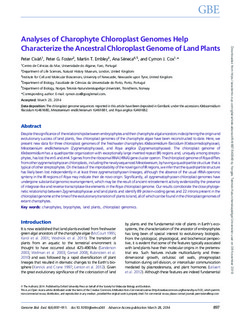| dc.contributor.author | Civan, P | |
| dc.contributor.author | Foster, PG | |
| dc.contributor.author | Embley, MT | |
| dc.contributor.author | Seneca, Ana | |
| dc.contributor.author | Cox, CJ | |
| dc.date.accessioned | 2019-11-07T11:00:02Z | |
| dc.date.available | 2019-11-07T11:00:02Z | |
| dc.date.created | 2014-08-29T13:50:18Z | |
| dc.date.issued | 2014 | |
| dc.identifier.citation | Genome Biology and Evolution. 2014, 6 (4), 897-911. | nb_NO |
| dc.identifier.issn | 1759-6653 | |
| dc.identifier.uri | http://hdl.handle.net/11250/2627162 | |
| dc.description.abstract | Despite the significance of the relationships between embryophytes and their charophyte algal ancestors in deciphering the origin and evolutionary success of land plants, few chloroplast genomes of the charophyte algae have been reconstructed to date. Here, we present new data for three chloroplast genomes of the freshwater charophytes Klebsormidium flaccidum (Klebsormidiophyceae), Mesotaenium endlicherianum (Zygnematophyceae), and Roya anglica (Zygnematophyceae). The chloroplast genome of Klebsormidium has a quadripartite organization with exceptionally large inverted repeat (IR) regions and, uniquely among streptophytes, has lost the rrn5 and rrn4.5 genes from the ribosomal RNA (rRNA) gene cluster operon. The chloroplast genome of Roya differs from other zygnematophycean chloroplasts, including the newly sequenced Mesotaenium, by having a quadripartite structure that is typical of other streptophytes. On the basis of the improbability of the novel gain of IR regions, we infer that the quadripartite structure has likely been lost independently in at least three zygnematophycean lineages, although the absence of the usual rRNA operonic synteny in the IR regions of Roya may indicate their de novo origin. Significantly, all zygnematophycean chloroplast genomes have undergone substantial genomic rearrangement, which may be the result of ancient retroelement activity evidenced by the presence of integrase-like and reverse transcriptase-like elements in the Roya chloroplast genome. Our results corroborate the close phylogenetic relationship between Zygnematophyceae and land plants and identify 89 protein-coding genes and 22 introns present in the chloroplast genome at the time of the evolutionary transition of plants to land, all of which can be found in the chloroplast genomes of extant charophytes. | nb_NO |
| dc.language.iso | eng | nb_NO |
| dc.publisher | Oxford University Press (OUP) | nb_NO |
| dc.rights | Navngivelse-Ikkekommersiell 4.0 Internasjonal | * |
| dc.rights.uri | http://creativecommons.org/licenses/by-nc/4.0/deed.no | * |
| dc.title | Analyses of charophyte chloroplast genomes help characterize theancestral chloroplastgenomeof land plants | nb_NO |
| dc.type | Journal article | nb_NO |
| dc.type | Peer reviewed | nb_NO |
| dc.description.version | publishedVersion | nb_NO |
| dc.source.pagenumber | 897-911 | nb_NO |
| dc.source.volume | 6 | nb_NO |
| dc.source.journal | Genome Biology and Evolution | nb_NO |
| dc.source.issue | 4 | nb_NO |
| dc.identifier.doi | 10.1093/gbe/evu061 | |
| dc.identifier.cristin | 1150404 | |
| dc.description.localcode | The Author(s) 2014. Published by Oxford University Press on behalf of the Society for Molecular Biology and Evolution. This is an Open Access article distributed under the terms of the Creative Commons Attribution Non-Commercial License (http://creativecommons.org/licenses/by-nc/3.0/), which permits non-commercial re-use, distribution, and reproduction in any medium, provided the original work is properly cited. For commercial re-use, please contact journals.permissions@oup.com | nb_NO |
| cristin.unitcode | 194,66,10,0 | |
| cristin.unitname | Institutt for biologi | |
| cristin.ispublished | true | |
| cristin.fulltext | original | |
| cristin.qualitycode | 1 | |

